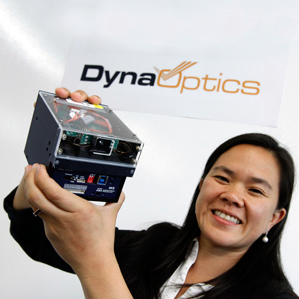Startup DynaOptics uses lenses that move from side to side, rather than forward and backward, for a high-quality optical zoom in smartphones.
- By Rachel Metz on October 3, 2014
Why It Matters
Many of us use a smartphone instead of a point-and-shoot camera, but a good optical zoom feature is still missing.

The CEO of DynaOptics, Li Han Chan, holds the development kit.
To pack a camera-quality optical zoom into a smartphone that’s still slender enough to fit into the pocket of some skinny jeans, a startup is building lenses that magnify by moving from side to side, rather than forward and backward.
Due in part to space constraints, most smartphone cameras rely on digital zoom, which uses software to simply blow up whatever the lens is focused on. This technique can result in pixilated photos. Optical zoom, in contrast, increases the distance between the lens and the image sensor, magnifying the details of the photo subject in a way that renders a clearer close-up.
DynaOptics says its optical zoom feature could be added to smartphone cameras without making handsets overly bulky. It uses a kind of progressive lens similar to what you see in bifocals, and moves them in an overlapping fashion from side to side to change zoom.
CEO and cofounder Li Han Chan says the company aims to have samples of its lenses ready for testing early next year. Assuming the tests go well, she says, phones featuring the lenses could be available by the end of 2015 or in early 2016. The components will cost several dollars apiece, Chan adds.
Many people have replaced point-and-shoot cameras with smartphones, but optical zoom is among the few key features that haven’t yet migrated over. “If you believe the vision that nobody’s ever going to have to carry two devices around again, that’s natural,” Chan says.
Chan showed me a DynaOptics lens in the palm of her hand. It’s a tiny rectangle of plastic that, unlike a regular curved lens, is part concave, part convex. Several of these lenses (Chan wouldn’t say how many) are packed within the company’s latest lens module prototype: a small black square about the size and thickness of a couple of stacked Scrabble tiles with an aperture on one side. This lens module, which also contains a simple electric motor, was connected to a box containing an image sensor, which was itself tethered to a laptop running the DynaOptics software.
The whole contraption faced a sort of checkerboard held up on its side. When Chan pressed a button on a connected remote control, the lenses moved sideways to overlap in predetermined positions, and a fuzzy, darkened image of the checkerboard shown on the laptop display immediately enlarged.
For now, the DyanOptics lens prototypes can magnify objects up to three times larger than they really are. Chan says the company expects to magnify objects up to five or six times—any higher might require the lens module to be larger.
The image quality, as I could see, still needs a lot of work; Chan freely admitted it’s “not that great yet.” DynaOptics needs to fine tune the lenses to improve it, she says.
Allen Yi, a professor at Ohio State University who has studied the kind of lenses used by DynaOptics, can see the appeal of optical zoom on a smartphone camera. and suspects others would, too. But he’s not sure how easy it will be for DynaOptics to create a reliable, robust lens system within the confines of a smartphone. “Whether they can actually get everything in a compact form and still work to the performance you need, I’m not really sure,” he says.
Chan is already thinking beyond the smartphone. She believes the technology could find a home in the cameras strapped to drones or robots. “We started with the mobile phone because that was the most applicable area for this technology, but there are cameras everywhere,” she says.

Nenhum comentário:
Postar um comentário
Observação: somente um membro deste blog pode postar um comentário.